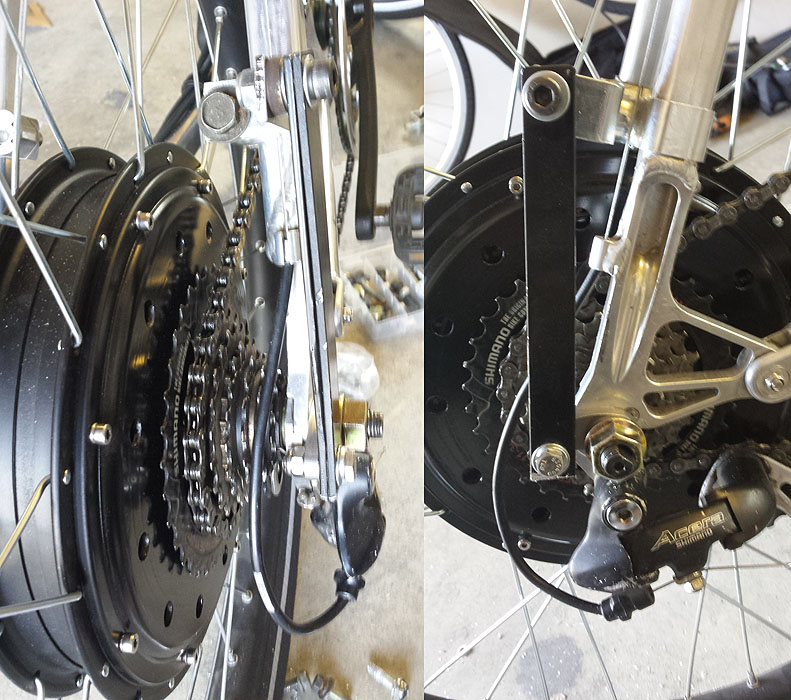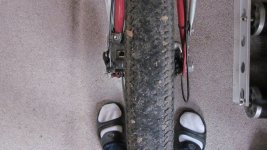thunderstorm80
1 kW
- Joined
- Mar 29, 2016
- Messages
- 383
Hi,
In my never-ending search for the ultimate electric touring bike, I thought to consider the Surly Pugsley frame.
It is a fat-bike frame, fully loaded with all kinds of rack eyelets including in the fork, made of chromoly steel, and has 135mm dropouts (both front and rear) which makes it easy to mount a standard rear motor without adaptors.
BUT, the price of the narrow 135mm rear dropout is a 17.5mm dishing offset of the hub toward the drive side on the right, so there won't be tire/chain rub issues and you can use regular triple crankset gearing.
17.5mm dishing is an extreme one, and I modelled this on the spoke simulator:
It looks quite disturbing, in terms of the spoke tension ratio. Although Grin says that even 80% ratio is possible on rear wheels, I think this is better to be avoidable since we talk about a heavy loaded touring bike that might also go on light off roads. On the other hands, the tires would be Surly black floyd 26x3.8 which make the entire bike (and the wheels) to a sort of sprung mass. This is why I like the idea of fat-bike as touring bike so much.
If you think it's still ok and reliable on the long term:
1. Shall I use thicker spokes like 13g or even 12g?
2. You can also see I placed all the left spokes outside and the right ones inside to minimize that stress ratio. It means there would be no crossing support between the spokes when doing cross "1". Do you think it's ok this way, and would you choose cross "0" since the swapping might already give enough angle for torque transmition ?
It would be interesting to hear what you think.
Ideally there would be another TC4080 running the front fork (since there is 135mm at the fork as well), giving awesome 2x2 for the heavy load, and allowing to climb (or descend) at very low speeds and still have very efficient electro-mechanical conversion ratio. (Whether it's forward torque or regen)
In my never-ending search for the ultimate electric touring bike, I thought to consider the Surly Pugsley frame.
It is a fat-bike frame, fully loaded with all kinds of rack eyelets including in the fork, made of chromoly steel, and has 135mm dropouts (both front and rear) which makes it easy to mount a standard rear motor without adaptors.
BUT, the price of the narrow 135mm rear dropout is a 17.5mm dishing offset of the hub toward the drive side on the right, so there won't be tire/chain rub issues and you can use regular triple crankset gearing.
17.5mm dishing is an extreme one, and I modelled this on the spoke simulator:
It looks quite disturbing, in terms of the spoke tension ratio. Although Grin says that even 80% ratio is possible on rear wheels, I think this is better to be avoidable since we talk about a heavy loaded touring bike that might also go on light off roads. On the other hands, the tires would be Surly black floyd 26x3.8 which make the entire bike (and the wheels) to a sort of sprung mass. This is why I like the idea of fat-bike as touring bike so much.
If you think it's still ok and reliable on the long term:
1. Shall I use thicker spokes like 13g or even 12g?
2. You can also see I placed all the left spokes outside and the right ones inside to minimize that stress ratio. It means there would be no crossing support between the spokes when doing cross "1". Do you think it's ok this way, and would you choose cross "0" since the swapping might already give enough angle for torque transmition ?
It would be interesting to hear what you think.
Ideally there would be another TC4080 running the front fork (since there is 135mm at the fork as well), giving awesome 2x2 for the heavy load, and allowing to climb (or descend) at very low speeds and still have very efficient electro-mechanical conversion ratio. (Whether it's forward torque or regen)



